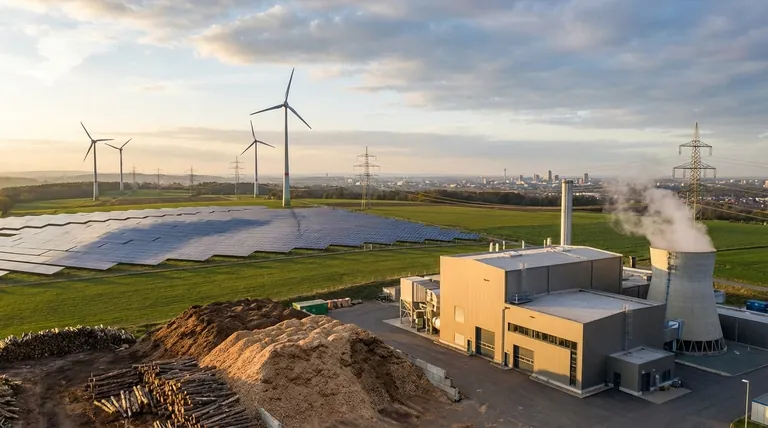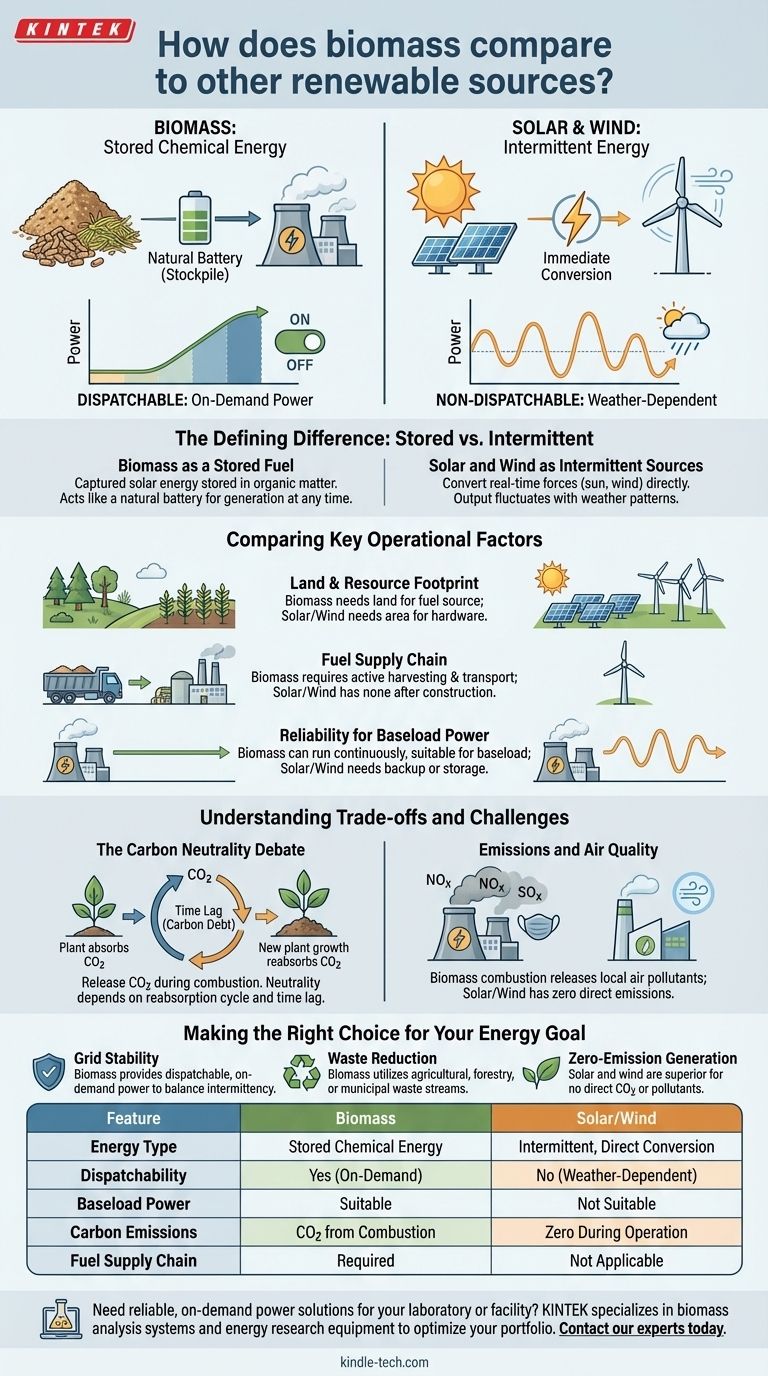When evaluating renewable energy sources, biomass stands apart due to its fundamental nature. Unlike intermittent sources like solar and wind that depend on immediate weather conditions, biomass is a form of stored chemical energy, derived from organic matter like wood, waste, and crops. This allows it to be converted into power on-demand, giving it a unique operational profile among renewables.
The core distinction is not which renewable source is "best," but how each functions within an energy system. Biomass offers dispatchable, on-demand power from a stored fuel, while solar and wind provide variable power. This makes biomass a potential stabilizing force for a grid increasingly reliant on intermittent sources.

The Defining Difference: Stored vs. Intermittent Energy
The most critical factor in comparing renewable sources is how they handle energy generation over time. This dictates their role, reliability, and integration into the power grid.
Biomass as a Stored Fuel
Biomass is essentially solar energy captured by plants through photosynthesis and stored in chemical bonds. This organic material—be it wood pellets, agricultural residue, or dedicated energy crops—can be stockpiled.
This stockpile acts like a natural battery. Power plants that use biomass can draw from this fuel reserve to generate electricity whenever it is needed, regardless of the time of day or weather.
Solar and Wind as Intermittent Sources
Solar and wind energy are fundamentally different. They convert immediate, real-time natural forces—sunlight and wind—directly into electricity.
This means their power output is inherently variable and cannot be controlled. Generation fluctuates based on weather patterns, creating challenges for grid operators who must constantly balance electricity supply and demand.
The Critical Concept of "Dispatchability"
This leads to the concept of dispatchability—the ability to control power output on demand.
Biomass power is dispatchable. Operators can ramp production up or down to match grid demand, a characteristic it shares with fossil fuel plants. In contrast, standard solar and wind installations are non-dispatchable; they produce what the prevailing conditions allow.
Comparing Key Operational Factors
Beyond dispatchability, these energy sources differ significantly in their physical and logistical requirements.
Land and Resource Footprint
Both biomass and other renewables require land, but for different purposes. Solar farms and wind turbines require significant surface area for their hardware.
Biomass requires land for its fuel source, whether it's a sustainably managed forest or fields for energy crops. This can create competition with agriculture or natural ecosystems if not managed carefully.
Fuel Supply Chain
A major distinction for biomass is its need for an active fuel supply chain. The organic material must be harvested, collected, processed, and transported to the power facility.
This creates logistical complexity and ongoing costs that do not exist for wind and solar after their initial construction.
Reliability for Baseload Power
Because it can run continuously, biomass is suitable for providing baseload power—the minimum level of electricity demand on a grid over a 24-hour period.
Its consistent and predictable output serves as a reliable foundation, complementing the fluctuating input from intermittent renewables and ensuring the grid remains stable.
Understanding the Trade-offs and Challenges
No energy source is without its drawbacks. The viability of biomass is the subject of significant debate and depends entirely on how it is sourced and managed.
The Carbon Neutrality Debate
Burning biomass releases carbon dioxide (CO2). The argument for it being "carbon neutral" rests on the idea that this is the same CO2 the plant absorbed from the atmosphere during its life.
However, this cycle is not instantaneous. There is a time lag, or "carbon debt," between the release of CO2 from combustion and its reabsorption by new plant growth. The length of this period is a point of major scientific and policy debate.
Sourcing and Sustainability
The sustainability of biomass is only as good as its feedstock. Using waste products like forest debris or agricultural residue is widely seen as beneficial.
Conversely, sourcing biomass from clear-cutting old-growth forests or using land that could be growing food raises serious environmental and ethical concerns.
Emissions and Air Quality
Unlike zero-emission sources like solar, wind, and hydropower, the combustion of biomass releases local air pollutants, including nitrogen oxides (NOx), sulfur oxides (SOx), and particulate matter.
These emissions require control technologies and can impact local air quality, representing a significant disadvantage compared to other renewables.
Making the Right Choice for Your Energy Goal
The optimal use of biomass is not as a blanket replacement for other renewables, but as a strategic component in a diversified energy portfolio.
- If your primary focus is grid stability: Biomass is a strong candidate to provide the dispatchable, on-demand power needed to balance the intermittency of solar and wind.
- If your primary focus is waste reduction: Using agricultural, forestry, or municipal solid waste as biomass fuel is an effective way to generate value from existing material streams.
- If your primary focus is zero-emission generation: Solar, wind, and hydropower are superior choices, as they produce no direct CO2 or local air pollutants during operation.
Ultimately, integrating biomass effectively depends on leveraging its unique reliability while meticulously managing its fuel source to ensure genuine sustainability.
Summary Table:
| Feature | Biomass | Solar/Wind |
|---|---|---|
| Energy Type | Stored Chemical Energy | Intermittent, Direct Conversion |
| Dispatchability | Yes (On-Demand) | No (Weather-Dependent) |
| Baseload Power | Suitable | Not Suitable |
| Carbon Emissions | CO2 from Combustion | Zero During Operation |
| Fuel Supply Chain | Required (Harvesting, Transport) | Not Applicable |
Need reliable, on-demand power solutions for your laboratory or facility? KINTEK specializes in lab equipment and consumables, including systems for biomass analysis and energy research. Our expertise can help you optimize your energy portfolio for maximum efficiency and stability. Contact our experts today to discuss how we can support your specific renewable energy goals!
Visual Guide

Related Products
- Customizable Laboratory High Temperature High Pressure Reactors for Diverse Scientific Applications
- Custom PTFE Teflon Parts Manufacturer for F4 PTFE Volumetric Bottle
- Conductive Boron Nitride BN Ceramics Composite for Advanced Applications
People Also Ask
- Is pressure reactor a laboratory apparatus? A Key Tool for High-Pressure Chemical Reactions
- What is the use of a pressure reactor? Control Reactions and Boost Yields
- How is high pressure generated in an autoclave? Unlock the Science of Sterilization & Synthesis
- What is a high pressure reactor? Your Guide to Safe, High-Yield Chemical Reactions
- How can you increase the pressure in a reactor? Master the Methods for Optimal Chemical Process Control


